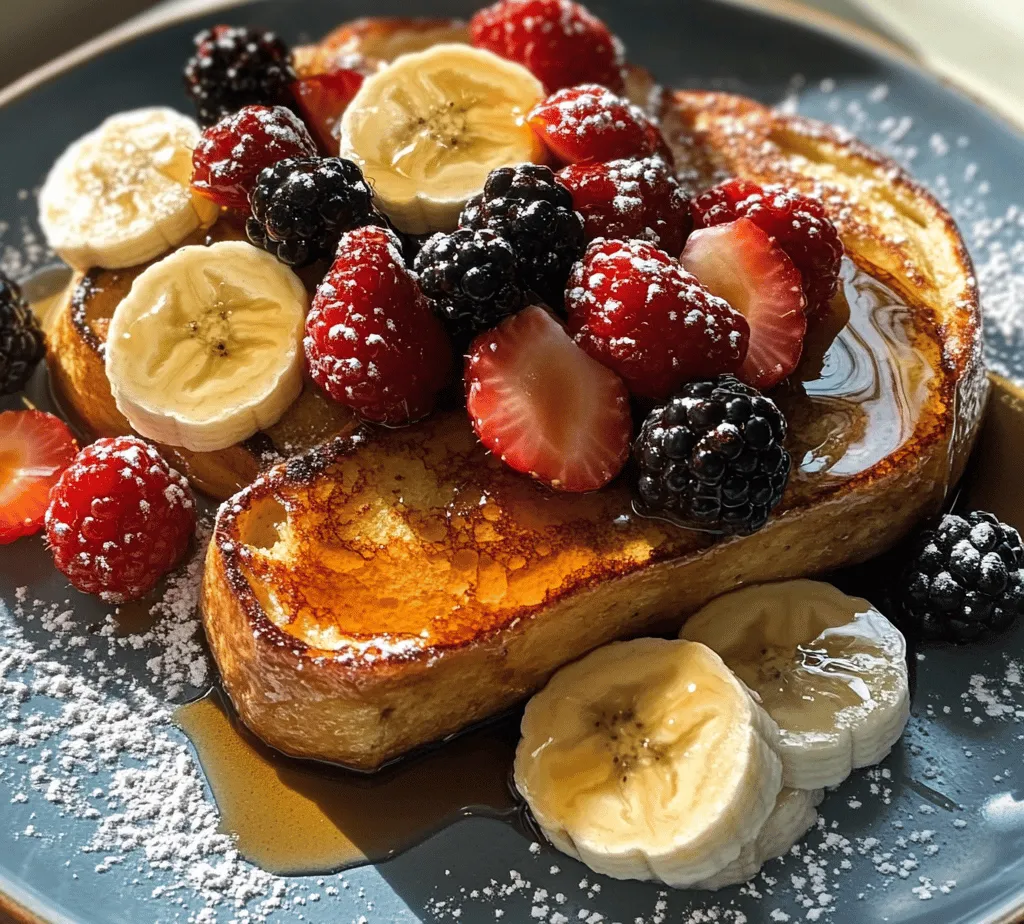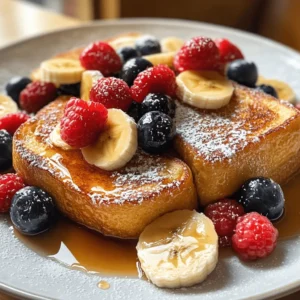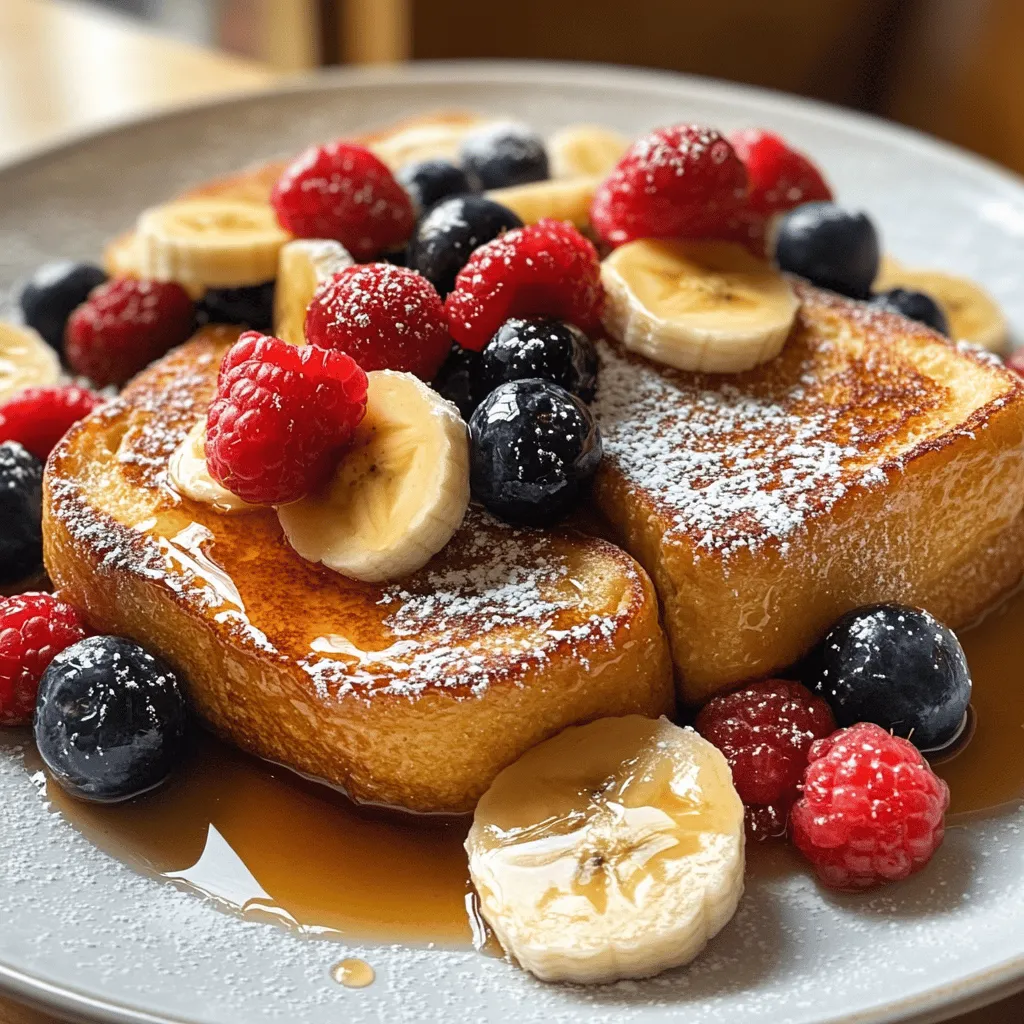Introduction
French toast is a beloved breakfast classic that has graced tables around the world for generations. Whether enjoyed as a quick weekday breakfast or a leisurely weekend brunch, this dish has a universal appeal, captivating taste buds with its delightful combination of custardy bread and warm, comforting flavors. But what if we could elevate this timeless dish into something truly extraordinary? Enter the “Caramelized Bliss” French Toast—a luxurious twist on the traditional recipe that promises to tantalize your senses.
Imagine sinking your teeth into slices of golden-brown bread, perfectly caramelized on the edges, with a rich custard flavor that dances on your palate. The caramelization process adds an irresistible sweetness and depth, transforming a simple breakfast into an indulgent experience. With its rich flavors and delightful textures, Caramelized Bliss French Toast is not just a meal; it’s a celebration of culinary creativity that will leave you longing for more.
In this article, we’ll explore the key aspects of making this heavenly dish, from understanding the importance of high-quality ingredients to detailed preparation steps that ensure your French toast turns out perfectly every time. Get ready to embark on a culinary adventure that will elevate your breakfast game to new heights!
Understanding the Ingredients
Importance of Using High-Quality Bread
The foundation of any great French toast lies in the choice of bread. While you can technically use any type of bread, opting for high-quality options like brioche or challah will significantly enhance the overall flavor and texture of your dish.
Brioche is a rich, buttery bread that has a soft and airy texture. Its delicate crumb makes it perfect for soaking up the custard mixture without becoming overly soggy. When cooked, brioche transforms into a light, fluffy treat with a slightly crisp exterior, making each bite a delightful experience.
Challah, on the other hand, is a traditional Jewish bread that is also rich and slightly sweet. It has a beautiful braided appearance and a tender crumb that holds up well during the soaking process. The slightly sweet flavor profile of challah pairs wonderfully with the caramelization, adding depth to each bite.
Choosing the right bread is crucial, as it influences not only the texture but also the overall flavor of your Caramelized Bliss French Toast.
The Role of Eggs and Milk in Creating the Custard Mixture
The custard mixture is the heart of any French toast recipe, and it’s primarily made up of eggs and milk. Eggs play a vital role in binding the ingredients together and providing structure, while milk adds creaminess and richness. The combination of these two ingredients creates a custard that envelops the bread, infusing it with flavor and moisture.
When preparing your custard, it’s essential to use fresh, high-quality eggs and whole milk for the best results. The richness of whole milk contributes to a creamier texture, while the eggs ensure that your French toast remains tender and fluffy. For an extra touch of indulgence, consider using heavy cream in place of milk for an even richer custard.
The Significance of Vanilla Extract and Cinnamon in Enhancing Flavor
To elevate the flavor profile of your Caramelized Bliss French Toast, don’t overlook the importance of vanilla extract and cinnamon.
Vanilla extract adds a warm, sweet aroma that complements the richness of the custard. It enhances the overall flavor without overpowering the dish, providing a subtle yet essential note that ties all the ingredients together.
Cinnamon, on the other hand, infuses your French toast with a warm, comforting spice that is synonymous with breakfast delights. Its aromatic quality adds depth and warmth, making each bite feel like a cozy hug.
Both of these ingredients are essential for creating a well-rounded flavor that will make your Caramelized Bliss French Toast truly unforgettable.
The Choice of Sugar: Brown Sugar vs. White Sugar and Its Impact on Flavor
Sugar plays a pivotal role in the caramelization process, which is what sets this recipe apart from traditional French toast. When it comes to choosing the right sugar, brown sugar is the star of the show.
Brown sugar contains molasses, which gives it a rich, deep flavor that adds complexity to your caramelized edges. As it melts and caramelizes during cooking, it develops a delightful sweetness that enhances the overall taste of the dish. The slight hint of toffee flavor from the brown sugar pairs perfectly with the custard-soaked bread, creating a beautifully balanced dish.
While white sugar can be used in a pinch, it lacks the depth and richness that brown sugar provides. If you’re looking to achieve that signature caramelized flavor, brown sugar is the way to go.
Optional Ingredients: Adding Bananas and Fresh Berries for Nutrition and Presentation
For those looking to amp up the nutrition and presentation of their Caramelized Bliss French Toast, consider adding optional ingredients like bananas and fresh berries.
Bananas can be sliced and layered on top of the French toast before cooking, or even cooked alongside the bread to caramelize them. Their natural sweetness and creamy texture create a delightful contrast to the rich custard, while also adding a healthy dose of potassium.
Fresh berries, such as strawberries, blueberries, or raspberries, not only add vibrant color but also provide a burst of freshness that cuts through the richness of the dish. They can be served on the side or used as a topping, adding both flavor and visual appeal.
Incorporating these fruits into your Caramelized Bliss French Toast not only enhances its nutritional value but also transforms it into a stunning centerpiece for any breakfast table.
Preparation Steps for Caramelized Bliss French Toast
Now that we’ve covered the essential ingredients, it’s time to dive into the preparation steps that will lead you to French toast perfection. The key to achieving that golden-brown caramelized exterior lies in the careful preparation of the custard and the cooking process.
Egg Mixture Preparation
Start by preparing the egg mixture that will serve as the custard for your French toast. In a large mixing bowl, crack the desired number of eggs—typically, two eggs will suffice for every two slices of bread. Whisk the eggs vigorously until they are fully blended and the yolks and whites are combined.
Next, add in the milk—about a half-cup per two eggs will do. If you’re feeling indulgent, replace some or all of the milk with heavy cream. Then, incorporate the essential flavor enhancers: a teaspoon of vanilla extract and a sprinkle of ground cinnamon.
Whisk the mixture until it is smooth and well combined. This step is crucial, as a well-blended custard will ensure even coating on the bread, preventing any clumps or uneven absorption during soaking.
Importance of Whisking to Achieve a Smooth Custard
When preparing the egg mixture, whisking is your best friend. Not only does it combine the ingredients, but it also incorporates air into the mixture, which contributes to the fluffiness of the final product. A smooth custard allows for better absorption by the bread, leading to a perfectly custardy interior once cooked.
Take your time during this step, as a well-whisked custard will yield superior results.
Preheating the Skillet: Why Temperature Matters for Cooking
While you’re preparing the custard, it’s essential to preheat your skillet or griddle. This step is often overlooked but is crucial for achieving that sought-after caramelization. A well-heated surface ensures that the bread begins to cook immediately upon contact, promoting even browning and preventing sogginess.
Set your skillet over medium heat and allow it to warm up for a few minutes before adding any oil or butter. A good test to check if your skillet is ready is to sprinkle a few drops of water onto the surface; if they dance and evaporate quickly, the skillet is ready for cooking.
The Soaking Technique: Ensuring Optimal Absorption Without Sogginess
Once your custard is prepared and your skillet is heated, it’s time to soak the bread. Start by slicing your brioche or challah into thick slices, about three-quarters of an inch thick. This thickness is key, as it allows for optimal absorption of the custard without becoming overly soggy.
Dip each slice of bread into the custard mixture, ensuring that both sides are thoroughly coated. However, be cautious not to let the bread soak for too long—about 20 to 30 seconds per side should suffice. The goal is to achieve a custardy interior while maintaining the structural integrity of the bread.
Cooking Process: Essential Tips for Achieving Golden-Brown Perfection
Now comes the exciting part—cooking your Caramelized Bliss French Toast! Begin by adding a generous pat of butter or a drizzle of oil to your preheated skillet. Allow it to melt and coat the surface evenly.
Carefully place the soaked bread slices into the skillet, making sure not to overcrowd the pan, as this can lead to uneven cooking. Once the bread is cooking, resist the temptation to move it around; let it sit undisturbed for about 3-4 minutes, allowing the caramelization to develop.
After a few minutes, check the underside of the bread. You’re looking for a beautiful golden-brown color, which indicates that caramelization is taking place. Flip the slices over and cook for another 3-4 minutes on the other side, adding more butter or oil as needed.
During the cooking process, keep a close eye on the heat. If the skillet is too hot, the outside may burn before the inside is cooked through. Conversely, if it’s too low, the caramelization process may be sluggish, resulting in a lackluster appearance and flavor. Adjust the heat as necessary to maintain a steady cooking temperature.
With these preparation steps, you are well on your way to creating a plate of Caramelized Bliss French Toast that will not only impress but also delight with every bite. Stay tuned for the next part of the article, where we will explore the finishing touches and serving suggestions to make this breakfast dish truly shine.

The Art of Caramelization: How to Sprinkle Sugar for Flavor and Texture
Caramelization is a crucial step in creating the rich, sweet flavor and irresistible texture of Caramelized Bliss French Toast. When you sprinkle sugar onto the bread, you initiate a beautiful transformation that elevates your breakfast. Here’s how to do it right:
1. Choose Your Sugar Wisely: For a classic caramel flavor, granulated sugar works wonderfully. However, for a unique twist, consider using brown sugar or coconut sugar, which adds a deeper, more complex flavor due to the molasses content.
2. Sprinkle Technique: Once you’ve dipped your bread in the egg mixture, place it on your skillet or griddle. Before flipping, sprinkle a thin, even layer of sugar on the side facing down. This ensures that as the bread cooks, the sugar melts and caramelizes, forming a delicious crust.
3. Monitor the Heat: Keep the heat at medium to medium-low. Too high a temperature can burn the sugar before it caramelizes, leading to a bitter taste. Patience is key here; let the sugar slowly melt and turn golden brown.
4. Perfect Flip: After a few minutes, once the sugar has formed a lovely caramel crust, gently flip the bread. You’ll see that the sugar has turned into a glossy, golden coating. This step is crucial, so take your time to ensure each slice gets the attention it deserves.
Serving Suggestions and Pairings
Ideal Serving Temperature
French toast is best enjoyed warm, right off the skillet. Serve it immediately after cooking to experience the delightful contrast of the warm, fluffy center and the crisp caramelized exterior. To keep the French toast warm while preparing multiple servings, place it on a baking sheet in a low oven (around 200°F) until ready to serve.
Drizzling with Maple Syrup
Nothing complements the sweetness of caramelized sugar like a drizzle of pure maple syrup. The rich, earthy flavors of maple perfectly balance the sweetness of the French toast, enhancing the overall experience. When choosing your maple syrup, opt for Grade A for a lighter flavor or Grade B for a more robust, deep taste.
Creative Garnishing Ideas
Elevate your Caramelized Bliss French Toast with garnishes that not only add visual appeal but also enhance flavor and nutrition:
– Banana Slices: Fresh banana slices add natural sweetness and creaminess, making each bite even more satisfying.
– Fresh Berries: Strawberries, blueberries, or raspberries provide a burst of tartness that cuts through the sweetness of the toast, adding a refreshing note.
Suggestions for Complementary Sides or Drinks
Pair this indulgent breakfast dish with a variety of sides or beverages to create a well-rounded meal:
– Coffee or Tea: A robust cup of coffee or a soothing cup of herbal tea can complement the richness of French toast, providing a delightful contrast.
– Fruit Juices: Freshly squeezed orange juice or a berry smoothie can add a refreshing element to your breakfast spread.
Nutritional Overview
While Caramelized Bliss French Toast is undeniably a treat, it also provides key nutrients that can fit into a balanced diet:
– Eggs: A primary ingredient in the recipe, eggs are a great source of protein and essential nutrients, including vitamins A, D, and B12.
– Whole Grain Bread: If you choose whole grain or whole wheat bread, you’ll benefit from added fiber, which aids digestion and promotes satiety.
– Milk: If you use dairy or fortified plant-based milk, this will add calcium and vitamin D to your meal.
Discussing the Balance of Indulgence and Nutrition
While indulgent, you can enjoy this French toast while still being mindful of nutrition. The key is moderation. Pairing it with fresh fruit and protein-rich sides can create a more balanced breakfast that satisfies both your cravings and your nutritional needs.
Tips for Modifying the Recipe for Dietary Preferences
To cater to various dietary preferences:
– Dairy-Free Options: Substitute cow’s milk with almond milk, soy milk, or oat milk. These alternatives provide similar textures and flavors without the dairy content.
– Gluten-Free: Use gluten-free bread to make this recipe accessible for those with gluten sensitivities.
– Low Sugar: Consider using a sugar substitute or reducing the amount of sugar used in the caramelization process for a lighter version.
Exploring Variations of Caramelized Bliss French Toast
Flavor Twists
Experimenting with different flavors can elevate your Caramelized Bliss French Toast:
– Spices: Adding spices such as cinnamon, nutmeg, or cardamom to the egg mixture can infuse your toast with warmth and depth.
– Extracts: A splash of vanilla or almond extract can enhance the overall flavor profile, making each bite a delightful surprise.
Alternative Toppings
The topping options for French toast are nearly limitless:
– Yogurt: A dollop of Greek yogurt can add creaminess and protein while balancing the sweetness.
– Whipped Cream: For a decadent twist, a light dollop of whipped cream can turn your breakfast into a dessert-like experience.
– Nut Butters: Spread some almond or peanut butter for a nutty flavor that pairs beautifully with the sweetness of the toast.
Savory Options
For those who prefer savory dishes, consider crafting a savory version of French toast:
– Cheese: Adding cheese like goat cheese or feta can create a unique flavor combination that contrasts with the sweetness of the caramel.
– Herbs: Incorporating fresh herbs like basil or chives into the egg mixture can provide an aromatic touch and a savory edge.
Tips for Perfecting Your French Toast
Achieving the perfect French toast requires attention to detail and some common sense techniques:
Common Pitfalls to Avoid
– Soggy Bread: Ensure your bread is slightly stale or toasted beforehand to prevent it from becoming overly soggy during the soaking process.
– Overcrowding the Pan: Cook in batches to avoid overcrowding the skillet, which can lead to steaming rather than caramelizing.
Recommendations on the Right Skillet or Griddle
A heavy-bottomed skillet or a non-stick griddle works best for French toast, providing even heat distribution. Cast iron skillets are particularly good for achieving that perfect caramelized crust.
Best Practices for Storing Leftovers and Reheating
If you happen to have leftovers (which is rare with this delicious dish), store them in an airtight container in the refrigerator. To reheat, place them in a preheated oven at 350°F for about 10-15 minutes or use a toaster oven for a crispy finish.
Conclusion
Caramelized Bliss French Toast is an indulgent yet simple breakfast option that combines the art of cooking with the joy of eating. The caramelization process is not only essential for flavor but also transforms this dish into a visually appealing feast. Don’t hesitate to experiment with different toppings, flavors, and variations to make it uniquely yours.
This delightful dish invites you to savor the experience of preparing it and enjoying it with loved ones. Whether it’s a special weekend brunch or a weekday treat, Caramelized Bliss French Toast is sure to become a favorite in your breakfast repertoire. So gather your ingredients, fire up the skillet, and enjoy the blissful experience of this sweet, caramelized delight.



